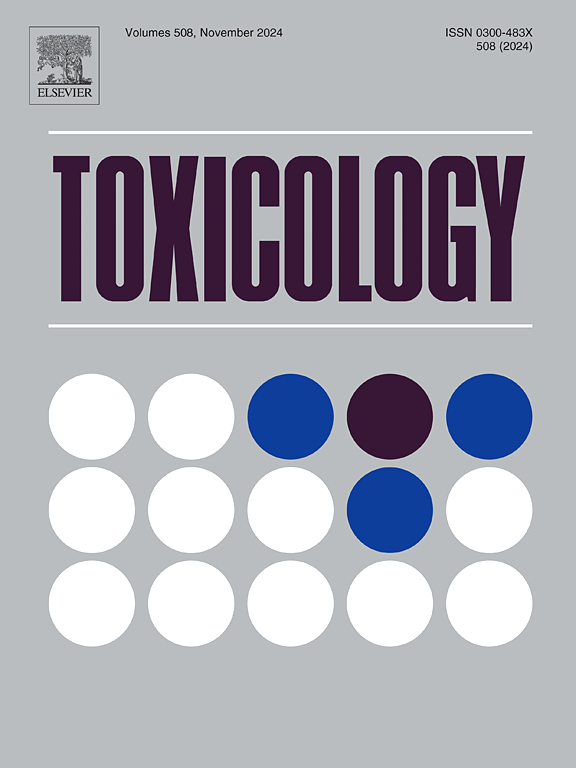人类有机阴离子转运体 1 (OAT1)、OAT2 和 OAT3 转运特定全氟烷基羧酸和全氟烷基磺酸的体外和硅学特征。
IF 4.8
3区 医学
Q1 PHARMACOLOGY & PHARMACY
引用次数: 0
摘要
全氟烷基羧酸(PFCAs)和全氟烷基磺酸(PFSAs)属于多氟和全氟烷基物质(PFASs),由于其排泄量有限,可能会在人体内蓄积。为了更深入地了解全氟辛烷磺酸在人体肾脏中的主动排泄潜力,本研究利用 OAT1、OAT2 或 OAT3 转导的人类胚胎肾脏(HEK)细胞,在体外研究了三种全氟砷酸(PFHpA、PFOA 和 PFNA)和三种全氟辛烷磺酸(PFBS、PFHxS 和 PFOS)的转运。只有 PFHpA 和 PFOA 在 OAT1 转化的 HEK 细胞中显示出明显的吸收,而在 OAT2 转化的 HEK 细胞中未观察到 PFASs 的转运。在 OAT3 转导的 HEK 细胞中,只有 PFHpA、PFOA、PFNA 和 PFHxS 有明显的吸收。为了研究 PFHpA 和 PFHxS 与转运体之间的相互作用,我们对这两种物质进行了分子对接和动力学模拟。体外转运的 PFAS(PFHpA 与 PFHxS)与非转运的 PFAS(PFHpA 与 PFHxS)并不总是能通过对接分析区分开来,而分子动力学模拟则可以,因为体外转运的 PFAS(PFHpA 与 OAT1,无与 OAT2,PFHpA 和 PFHxS 与 OAT3)只检测到 PFAS 与转运口内部的稳定相互作用。总之,本研究对人体肾分泌转运体 OAT1、OAT2 和 OAT3 转运选定的全氟辛烷磺酸进行了体外和硅学研究,从而进一步了解了全氟辛烷磺酸同系物在人体内蓄积能力的差异。本文章由计算机程序翻译,如有差异,请以英文原文为准。
In vitro and in silico characterization of the transport of selected perfluoroalkyl carboxylic acids and perfluoroalkyl sulfonic acids by human organic anion transporter 1 (OAT1), OAT2 and OAT3
Perfluoroalkyl carboxylic acids (PFCAs) and perfluoroalkyl sulfonic acids (PFSAs) belong to the group of poly- and perfluoroalkyl substances (PFASs), which may accumulate in humans due to their limited excretion. To provide more insights into the active renal excretion potential of PFASs in humans, this work investigated in vitro the transport of three PFCAs (PFHpA, PFOA, PFNA) and three PFSAs (PFBS, PFHxS and PFOS) using OAT1-, OAT2- or OAT3-transduced human embryonic kidney (HEK) cells. Only PFHpA and PFOA showed clear uptake in OAT1-transduced HEK cells, while no transport was observed for PFASs in OAT2-transduced HEK cells. In OAT3-transduced HEK cells only PFHpA, PFOA, PFNA, and PFHxS showed clear uptake. To study the interaction with the transporters, molecular docking and dynamics simulations were performed for PFHpA and PFHxS, for which a relatively short and long half-lives in humans has been reported, respectively. Docking analyses could not always distinguish the in vitro transported from the non-transported PFASs (PFHpA vs. PFHxS), whereas molecular dynamic simulations could, as only a stable interaction of the PFAS with the inner part of transporter mouth was detected for those that were transported in vitro (PFHpA with OAT1, none with OAT2, and PFHpA and PFHxS with OAT3). Altogether, this study presents in vitro and in silico insight with respect to the selected PFASs transport by the human renal secretory transporters OAT1, OAT2, and OAT3, which provides further understanding about the differences between the capability of PFAS congeners to accumulate in humans.
求助全文
通过发布文献求助,成功后即可免费获取论文全文。
去求助
来源期刊

Toxicology
医学-毒理学
CiteScore
7.80
自引率
4.40%
发文量
222
审稿时长
23 days
期刊介绍:
Toxicology is an international, peer-reviewed journal that publishes only the highest quality original scientific research and critical reviews describing hypothesis-based investigations into mechanisms of toxicity associated with exposures to xenobiotic chemicals, particularly as it relates to human health. In this respect "mechanisms" is defined on both the macro (e.g. physiological, biological, kinetic, species, sex, etc.) and molecular (genomic, transcriptomic, metabolic, etc.) scale. Emphasis is placed on findings that identify novel hazards and that can be extrapolated to exposures and mechanisms that are relevant to estimating human risk. Toxicology also publishes brief communications, personal commentaries and opinion articles, as well as concise expert reviews on contemporary topics. All research and review articles published in Toxicology are subject to rigorous peer review. Authors are asked to contact the Editor-in-Chief prior to submitting review articles or commentaries for consideration for publication in Toxicology.
 求助内容:
求助内容: 应助结果提醒方式:
应助结果提醒方式:


